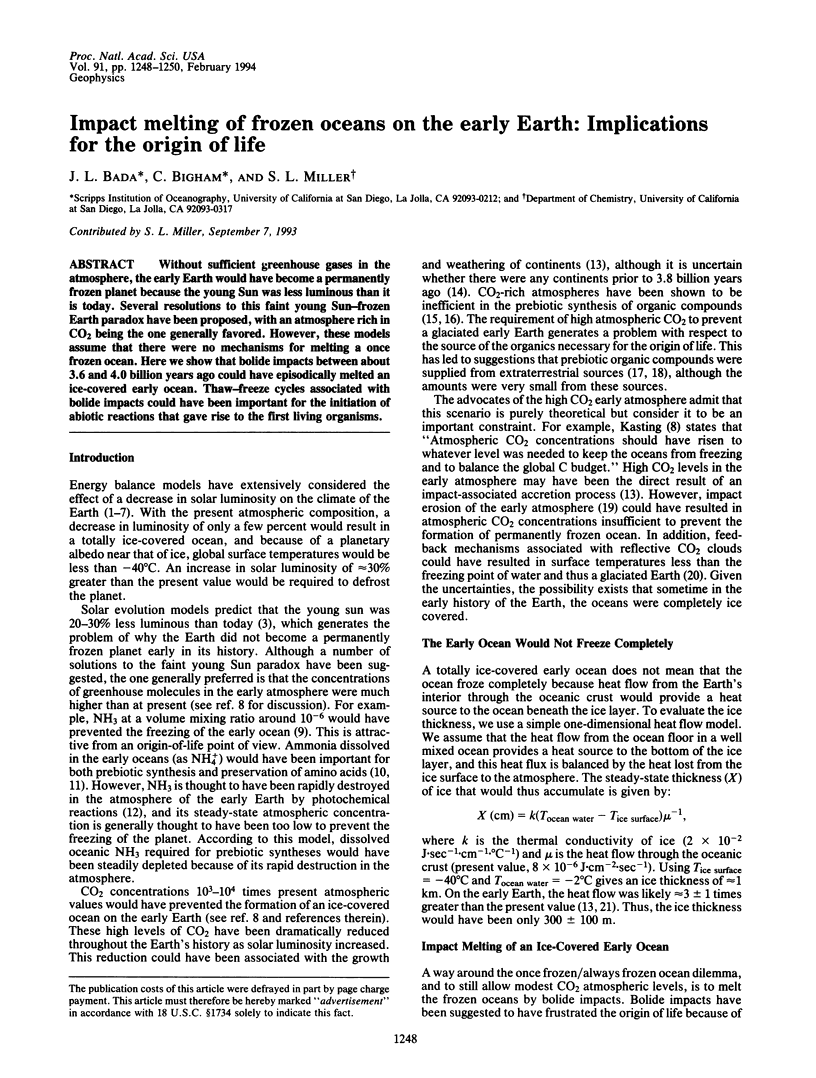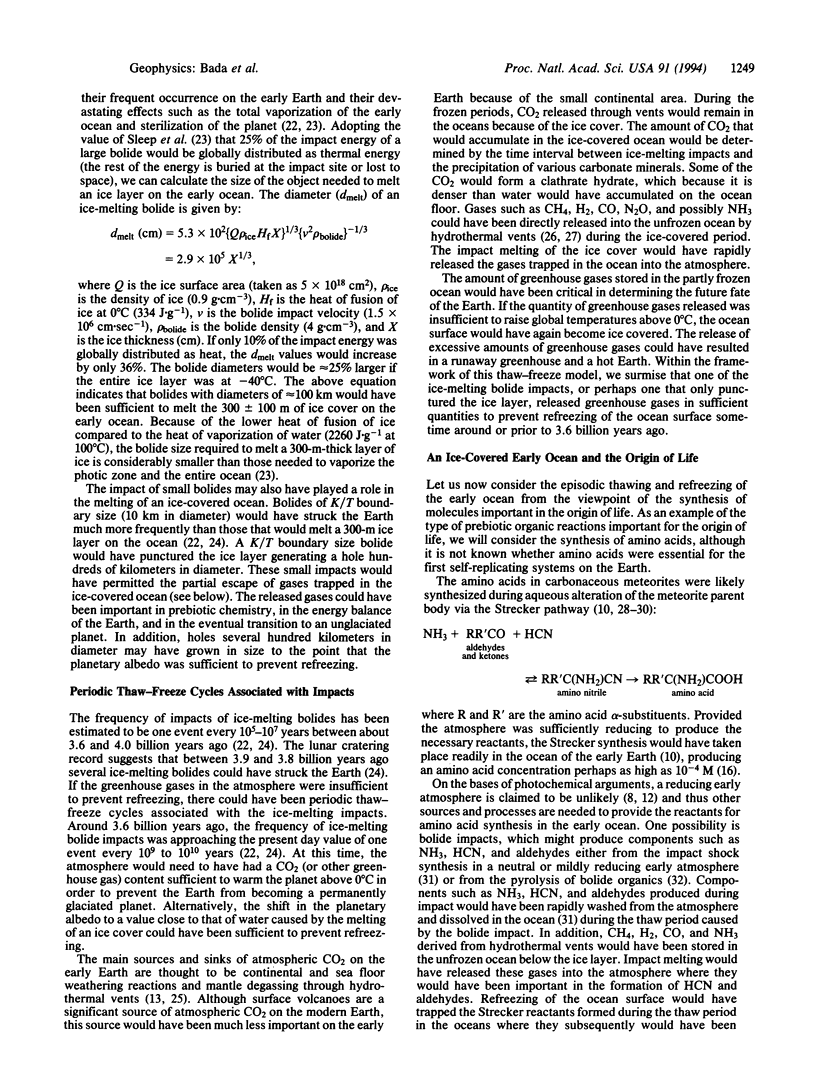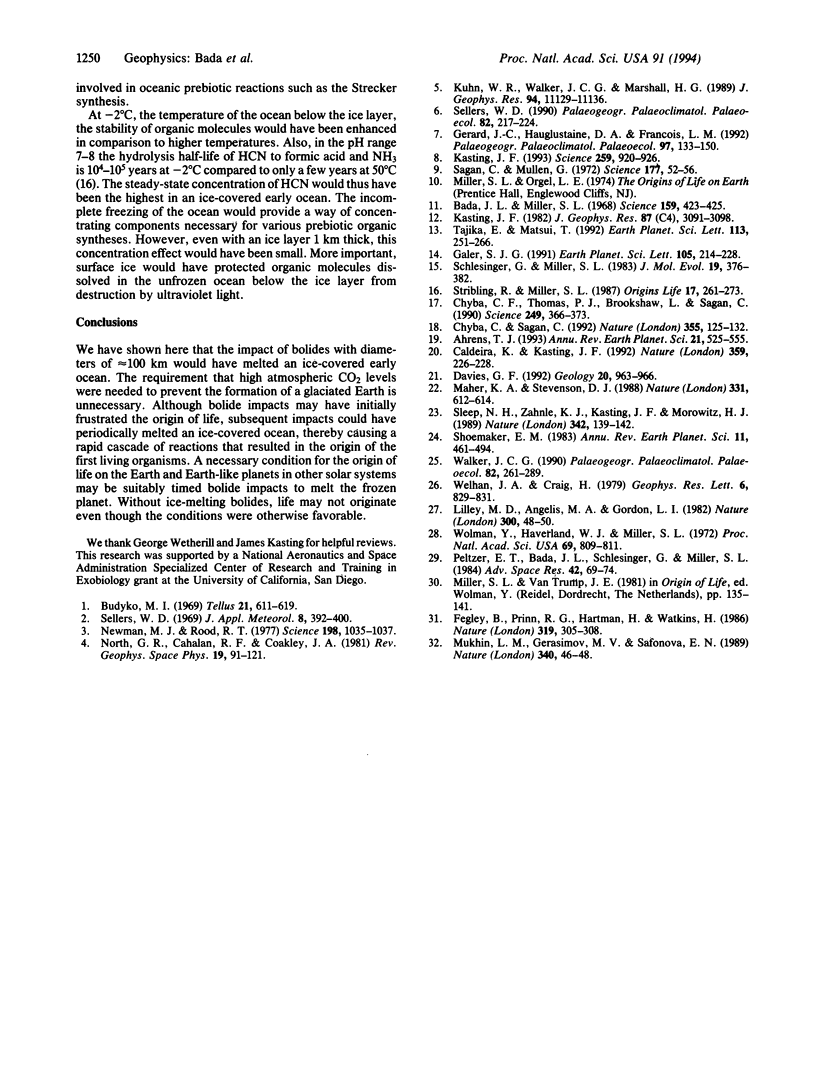Abstract
Without sufficient greenhouse gases in the atmosphere, the early Earth would have become a permanently frozen planet because the young Sun was less luminous than it is today. Several resolutions to this faint young Sun-frozen Earth paradox have been proposed, with an atmosphere rich in CO2 being the one generally favored. However, these models assume that there were no mechanisms for melting a once frozen ocean. Here we show that bolide impacts between about 3.6 and 4.0 billion years ago could have episodically melted an ice-covered early ocean. Thaw-freeze cycles associated with bolide impacts could have been important for the initiation of abiotic reactions that gave rise to the first living organisms.
Full text
PDF


Selected References
These references are in PubMed. This may not be the complete list of references from this article.
- Bada J. L., Miller S. L. Ammonium ion concentration in the primitive ocean. Science. 1968 Jan 26;159(3813):423–425. doi: 10.1126/science.159.3813.423. [DOI] [PubMed] [Google Scholar]
- Caldeira K., Kasting J. F. Susceptibility of the early Earth to irreversible glaciation caused by carbon dioxide clouds. Nature. 1992 Sep 17;359:226–228. doi: 10.1038/359226a0. [DOI] [PubMed] [Google Scholar]
- Chyba C. F., Thomas P. J., Brookshaw L., Sagan C. Cometary delivery of organic molecules to the early Earth. Science. 1990 Jul 27;249:366–373. doi: 10.1126/science.11538074. [DOI] [PubMed] [Google Scholar]
- Chyba C., Sagan C. Endogenous production, exogenous delivery and impact-shock synthesis of organic molecules: an inventory for the origins of life. Nature. 1992 Jan 9;355:125–132. doi: 10.1038/355125a0. [DOI] [PubMed] [Google Scholar]
- Fegley B., Jr, Prinn R. G., Hartman H., Watkins G. H. Chemical effects of large impacts on the Earth's primitive atmosphere. Nature. 1986 Jan 23;319:305–308. doi: 10.1038/319305a0. [DOI] [PubMed] [Google Scholar]
- Kasting J. F. Earth's early atmosphere. Science. 1993 Feb 12;259(5097):920–926. doi: 10.1126/science.11536547. [DOI] [PubMed] [Google Scholar]
- Kuhn W. R., Walker J. C., Marshall H. G. The effect on Earth's surface temperature from variations in rotation rate, continent formation, solar luminosity, and carbon dioxide. J Geophys Res. 1989 Aug 20;94(D8):11129–11136. doi: 10.1029/jd094id08p11129. [DOI] [PubMed] [Google Scholar]
- Maher K. A., Stevenson D. J. Impact frustration of the origin of life. Nature. 1988 Feb 18;331(6157):612–614. doi: 10.1038/331612a0. [DOI] [PubMed] [Google Scholar]
- Newman M. J., Rood R. T. Implications of Solar Evolution for the Earth's Early Atmosphere. Science. 1977 Dec 9;198(4321):1035–1037. doi: 10.1126/science.198.4321.1035. [DOI] [PubMed] [Google Scholar]
- Peltzer E. T., Bada J. L., Schlesinger G., Miller S. L. The chemical conditions on the parent body of the Murchison meteorite: some conclusions based on amino, hydroxy and dicarboxylic acids. Adv Space Res. 1984;4(12):69–74. doi: 10.1016/0273-1177(84)90546-5. [DOI] [PubMed] [Google Scholar]
- Sagan C., Mullen G. Earth and Mars: evolution of atmospheres and surface temperatures. Science. 1972 Jul 7;177(4043):52–56. doi: 10.1126/science.177.4043.52. [DOI] [PubMed] [Google Scholar]
- Schlesinger G., Miller S. L. Prebiotic synthesis in atmospheres containing CH4, CO, and CO2. I. Amino acids. J Mol Evol. 1983;19(5):376–382. doi: 10.1007/BF02101642. [DOI] [PubMed] [Google Scholar]
- Sleep N. H., Zahnle K. J., Kasting J. F., Morowitz H. J. Annihilation of ecosystems by large asteroid impacts on the early Earth. Nature. 1989 Nov 9;342(6246):139–142. doi: 10.1038/342139a0. [DOI] [PubMed] [Google Scholar]
- Stribling R., Miller S. L. Energy yields for hydrogen cyanide and formaldehyde syntheses: the HCN and amino acid concentrations in the primitive ocean. Orig Life Evol Biosph. 1987;17(3-4):261–273. doi: 10.1007/BF02386466. [DOI] [PubMed] [Google Scholar]
- Walker J. C. Precambrian evolution of the climate system. Glob Planet Change. 1990;82:261–289. [PubMed] [Google Scholar]
- Wolman Y., Haverland W. J., Miller S. L. Nonprotein amino acids from spark discharges and their comparison with the murchison meteorite amino acids. Proc Natl Acad Sci U S A. 1972 Apr;69(4):809–811. doi: 10.1073/pnas.69.4.809. [DOI] [PMC free article] [PubMed] [Google Scholar]


